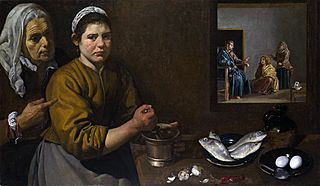Christ in the House of Martha and Mary (Velázquez) facts for kids
Quick facts for kids Christ in the House of Martha and Mary |
|
|---|---|
 |
|
| Artist | Diego Velázquez |
| Year | 1618 |
| Medium | Oil on canvas |
| Dimensions | 63 cm × 103.5 cm (25 in × 40.7 in) |
| Location | National Gallery, London |
Christ in the House of Martha and Mary is an oil painting by the Spanish artist Diego Velázquez. He created it in 1618, soon after finishing his art training. This painting is now kept at the National Gallery, London in the United Kingdom.
At this time, Velázquez was exploring a type of painting called bodegones. These paintings often showed everyday scenes from kitchens or taverns. The word bodegón means "tavern" in Spanish. Artists often used these scenes to connect daily life in Spain with stories from the Bible. Many bodegones paintings showed people working with food and drinks.
What the Painting Shows
This painting shows a kitchen scene with two women. One woman, likely Martha, is busy preparing food. She looks a bit upset. In the background, you can see a smaller scene through a doorway or window. This scene shows Jesus talking to Mary.
The story comes from the Bible. Martha was busy serving guests, while her sister Mary sat and listened to Jesus. Martha complained that Mary wasn't helping. Jesus told Martha that Mary had chosen the "better part" by listening to him. Velázquez often used these everyday settings to tell religious stories.
Artistic Influences
Velázquez was influenced by art from Flanders, a region in Europe. Artists like Pieter Aertsen and Joachim Beuckelaer from the 1500s created large paintings. These paintings often combined a small Bible scene in the background with a busy kitchen scene in the front. The kitchen scenes usually featured amazing still life paintings of food.
Some of these Flemish paintings also showed Christ, Martha, and Mary in the background. Velázquez likely saw pictures or engravings of these types of artworks. This helped him develop his own unique style.
History of the Painting
This painting might have belonged to a Spanish duke named Fernando Afán de Ribera. In 1637, an inventory of his house described a painting by Velázquez as "a kitchen where a woman is pounding garlic". It did not mention the religious scene at all.
The painting later came to England. It was eventually bought by Sir William Henry Gregory. He gave it to the National Gallery in 1892, where it has been ever since.
See also
- List of works by Diego Velázquez
- In Spanish: Cristo en casa de Marta y María (Velázquez) para niños

